
What is zinc dross?
It is a by-product or waste material produced during the galvanizing process, which involves coating steel or iron with a layer of zinc to prevent corrosion. When zinc is melted to coat the steel, impurities from the zinc and iron interact and form solid particles that float on the surface of the molten zinc. These solid particles, referred to as zinc dross, are removed from the surface and collected.
There are different types of zinc dross, including:
- Top Dross: Forms on the surface of the molten zinc bath and consists of oxidized zinc and iron.
- Bottom Dross: Settles at the bottom of the zinc bath and contains higher concentrations of iron.
Top and Bottom dross still contains a significant amount of usable zinc, which can be recycled and recovered through various refining processes, including the use of furnaces or chemical methods. It is considered valuable as it can be processed back into usable zinc for industrial purposes.
Chemical composition of zinc dross
The chemical composition of Top and bottom dross can vary depending on the production process and its source. However, typical components include:
- Zinc (Zn): The primary element, usually accounting for 85% to 95%.
- Iron (Fe): Ranges from 1% to 10%, mainly due to reactions between zinc and iron during the galvanizing process.
- Aluminum (Al): Can make up 0.5% to 3%, depending on whether aluminum is added during the galvanizing process.
- Lead (Pb): Typically present in small amounts, about 0.1% to 1%.
- Tin (Sn): May also be present in trace amounts.
- Zinc Oxides (ZnO): These can form on the surface due to oxidation.
- Other impurities: Small traces of metals or elements such as cadmium (Cd), copper (Cu), and silicon (Si) may be present.
The proportions of these components vary based on the technology used and the type of galvanizing process (e.g., hot-dip or electroplating).
How to recycle zinc dross?
Recycling Top and Bottom dross involves recovering the usable zinc content from the by-product of the galvanizing process. The process generally follows several key steps, which may vary depending on the technology and equipment used. Here’s an outline of how zinc dross can be recycled:
1. Collection and Sorting
Zinc dross is collected from the galvanizing plant, and sorting may be done to separate top dross from bottom dross. Bottom dross typically has a higher iron content, while top dross has more zinc oxide.
2. Crushing and Screening
The dross is usually crushed to break it down into smaller particles. Screening or sieving is done to separate larger metallic zinc particles from the finer zinc oxide and iron-containing materials.
3. Separation and Recovery
Depending on the composition of the dross, different methods are used to recover zinc:
- Mechanical Separation: Larger metallic zinc particles are separated using gravity or magnetic separation, leaving behind oxides and other non-zinc materials.
- Pyrometallurgical Process (Smelting):
- Rotary Furnace or Reverberatory Furnace: The crushed dross is melted in a furnace at high temperatures, where Zn is vaporized or melted out of the dross. Zinc metal is then collected as molten zinc, while the remaining non-zinc materials are discarded as slag.
- In some cases, additives such as fluxes are used to help separate the zinc from iron and other contaminants.
- Distillation: Zinc can also be recovered using a distillation process, where the dross is heated in a vacuum to vaporize the zinc, which is then condensed back into liquid form and collected.
4. Refining and Purification
The recovered zinc metal from the smelting process is often impure and may need further remove contaminants. This can be done through electrolysis or additional smelting steps, depending on the desired purity of the zinc.
5. Zinc Oxide Recovery
If the goal is to produce zinc oxide rather than metallic zinc, the dross can be processed in a Waelz kiln process to get Zinc Oxide powder.
6. End Products
- Recovered Zinc Metal: The primary product is zinc metal, which can be reused in galvanizing, alloy production, or other industries.
- Zinc Oxide: If the process is designed to recover zinc oxide, this material can be used in rubber, paint, ceramics, and other industries.
.
Environmental Considerations
- Proper management of the non-recoverable waste (slag) is important, and many recycling facilities ensure that the waste is disposed of or used in a way that minimizes environmental impact.
- Dust and emissions from the furnace operations need to be controlled using filters or other environmental protection systems.
By recycling Top and Bottom dross, valuable zinc can be recovered and reused, reducing the need for new zinc mining and lowering the environmental footprint of zinc production.


